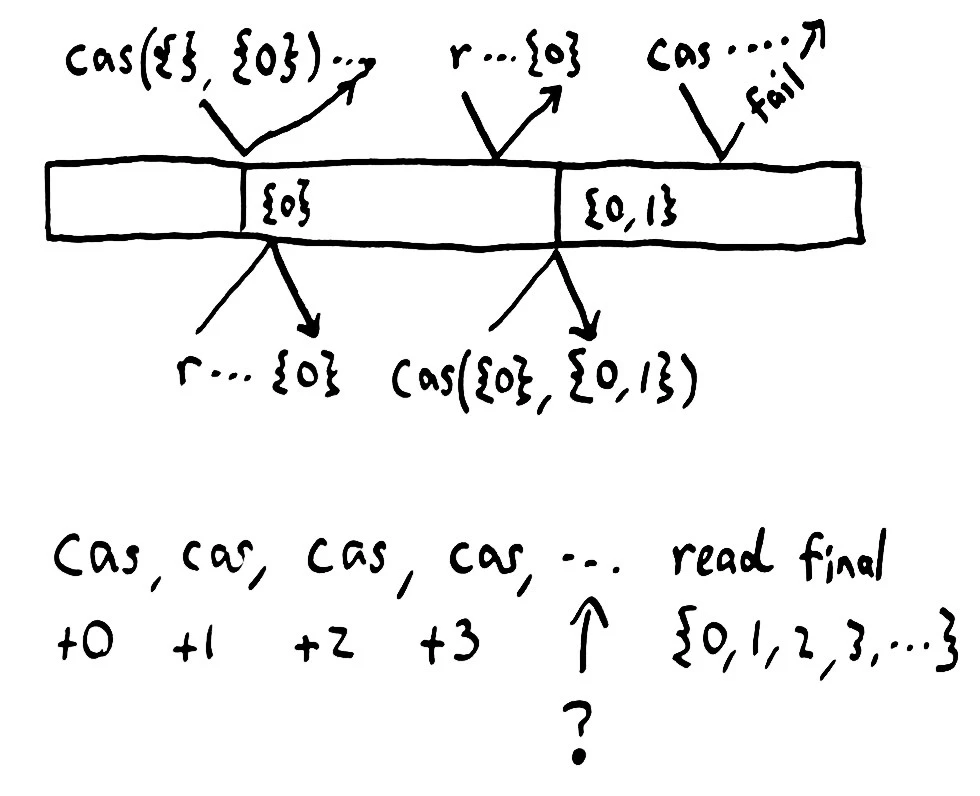So there’s a blog post that advises every method should, when possible, return self. I’d like to suggest you do the opposite: wherever possible, return something other than self.
Mutation is hard
Mutation makes code harder to reason about. Mutable objects make equality comparisons tricky: if you use a mutable object as the key in a hashmap, for instance, then change one of its fields, what happens? Can you access the value by the new string value? By the old one? What about a set? An array? For a fun time, try these in various languages. Try it with mutable primitives, like Strings, if the language makes a distinction. Enjoy the results.
Previously: Modeling.
Writing software can be an exercise in frustration. Useless error messages, difficult-to-reproduce bugs, missing stacktrace information, obscure functions without documentation, and unmaintained libraries all stand in our way. As software engineers, our most useful skill isn’t so much knowing how to solve a problem as knowing how to explore a problem that we haven’t seen before. Experience is important, but even experienced engineers face unfamiliar bugs every day. When a problem doesn’t bear a resemblance to anything we’ve seen before, we fall back on general cognitive strategies to explore–and ultimately solve–the problem.
There’s an excellent book by the mathematician George Polya: How to Solve It, which tries to catalogue how successful mathematicians approach unfamiliar problems. When I catch myself banging my head against a problem for more than a few minutes, I try to back up and consider his principles. Sometimes, just taking the time to slow down and reflect can get me out of a rut.
With the language fundamentals in hand, here’s my thinking for the remainder of the Clojure from the ground up book chapters. I’m putting Jepsen on hold to work on this project for the rest of the year; hoping to get the source material complete by… January?
- Debugging and getting help
- Polymorphism
- Error Handling
- Modularization and refactoring
- It’s not at all obvious what an object is
- JVM interop
- The Clojure type system
- Compiler at runtime
- Build your own language
- Performance analysis
- Parsers and protocols
- Storage and persistence
- Networks and messaging
- Concurrency and queues

This post covers Elasticsearch 1.1.0. In the months since its publication, Elasticsearch has added a comprehensive overview of correctness issues and their progress towards fixing some of these bugs.
In the previous post, we discovered the potential for data loss in RabbitMQ clusters. In this oft-requested installation of the Jepsen series, we’ll look at etcd: a new contender in the CP coordination service arena. We’ll also discuss Consul’s findings with Jepsen.
Like Zookeeper, etcd is designed to store small amounts of strongly-consistent state for coordination between services. It exposes a tree of logical nodes; each identified by a string key, containing a string value, and with a version number termed an index–plus, potentially, a set of child nodes. Everything’s exposed as JSON over an HTTP API.
Etcd is often used for service discovery, distributed locking, atomic broadcast, sequence numbers, and pointers to data in eventually consistent stores. Because etcd offers atomic compare-and-set by both value and version index, it’s a powerful primitive in building other distributed systems.

RabbitMQ is a distributed message queue, and is probably the most popular open-source implementation of the AMQP messaging protocol. It supports a wealth of durability, routing, and fanout strategies, and combines excellent documentation with well-designed protocol extensions. I’d like to set all these wonderful properties aside for a few minutes, however, to talk about using your queue as a lock service. After that, we’ll explore RabbitMQ’s use as a distributed fault-tolerant queue.
Earlier versions of Jepsen found glaring inconsistencies, but missed subtle ones. In particular, Jepsen was not well equipped to distinguish linearizable systems from sequentially or causally consistent ones. When people asked me to analyze systems which claimed to be linearizable, Jepsen could rule out obvious classes of behavior, like dropping writes, but couldn’t tell us much more than that. Since users and vendors are starting to rely on Jepsen as a basic check on correctness, it’s important that Jepsen be able to identify true linearization errors.

Update, 2018-08-24: For a more complete, formal discussion of consistency models, see jepsen.io.
Network partitions are going to happen. Switches, NICs, host hardware, operating systems, disks, virtualization layers, and language runtimes, not to mention program semantics themselves, all conspire to delay, drop, duplicate, or reorder our messages. In an uncertain world, we want our software to maintain some sense of intuitive correctness.
Well, obviously we want intuitive correctness. Do The Right Thing(TM)! But what exactly is the right thing? How might we describe it? In this essay, we’ll take a tour of some “strong” consistency models, and see how they fit together.
Previously: Logistics
Until this point in the book, we’ve dealt primarily in specific details: what an expression is, how math works, which functions apply to different data structures, and where code lives. But programming, like speaking a language, painting landscapes, or designing turbines, is about more than the nuts and bolts of the trade. It’s knowing how to combine those parts into a cohesive whole–and this is a skill which is difficult to describe formally. In this part of the book, I’d like to work with you on an integrative tour of one particular problem: modeling a rocket in flight.
We’re going to reinforce our concrete knowledge of the standard library by using maps, sequences, and math functions together. At the same time, we’re going to practice how to represent a complex system; decomposing a problem into smaller parts, naming functions and variables, and writing tests.
Previously, we covered state and mutability.
Up until now, we’ve been programming primarily at the REPL. However, the REPL is a limited tool. While it lets us explore a problem interactively, that interactivity comes at a cost: changing an expression requires retyping the entire thing, editing multi-line expressions is awkward, and our work vanishes when we restart the REPL–so we can’t share our programs with others, or run them again later. Moreover, programs in the REPL are hard to organize. To solve large problems, we need a way of writing programs durably–so they can be read and evaluated later.
In addition to the code itself, we often want to store ancillary information. Tests verify the correctness of the program. Resources like precomputed databases, lookup tables, images, and text files provide other data the program needs to run. There may be documentation: instructions for how to use and understand the software. A program may also depend on code from other programs, which we call libraries, packages, or dependencies. In Clojure, we have a standardized way to bind together all these parts into a single directory, called a project.
mrb_bk brought up this wonderful quote today.
What good are impossibility results, anyway? They don’t seem very useful at first, since they don’t allow computers to do anything they couldn’t previously.
Most obviously, impossibility results tell you when you should stop trying to devise or improve an algorithm. This information can be useful both for theoretical research and for systems development work.
It is probably true that most systems developers, even when confronted with the proved impossibility of what they’re trying to do, will still keep trying to do it. This doesn’t necessarily mean that they are obstinate, but rather that they have some flexibility in their goals. E.g., if they can’t accomplish something absolutely, maybe they can settle for a solution that works with “sufficiently high probability”. In such a case, the effect of the impossibility result might be to make a systems developer clarify his/her claims about what the system accomplishes.
–The inimitable Nancy Lynch, in A Hundred Impossibility Proofs for Distributed Computing
A few weeks ago I criticized a proposal by Antirez for a hypothetical linearizable system built on top of Redis WAIT and a strong coordinator. I showed that the coordinator he suggested was physically impossible to build, and that anybody who tried to actually implement that design would run into serious problems. I demonstrated those problems (and additional implementation-specific issues) in an experiment on Redis’ unstable branch.
Antirez’ principal objections, as I understand them, are:
- Some readers mistakenly assumed that the system I discussed was a proposal for Redis Cluster.
- I showed that the proposal was physically impossible, but didn’t address its safety if it were possible.
- The impossible parts of the proposed system could be implemented in a real asynchronous network by layering in additional constraints on the leader election process.